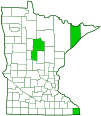Wood Ear
(Auricularia angiospermarum)
Conservation • Description • Habitat • Ecology • Distribution • Taxonomy
Conservation Status |
|
|||||||
| IUCN Red List | not listed |
|||||||
| NatureServe | NNR - Unranked |
|||||||
| Minnesota | not listed |
|||||||
Description |
||
There are at least three Auricularia species in North America: Jelly Tree Ear (Auricularia americana) grows on conifers; Wood Ear (Auricularia angiospermarum) grows on hardwoods and is widespread; and Auricularia fuscosuccinea (no common name) grows on hardwoods. The first two of these occur in Minnesota, the third is restricted to the southeast. Wood Ear is a gelatinous ear-like fungus. It occurs in the United States from Connecticut to Georgia, west to Minnesota, Missouri, and eastern Texas; in southern Quebec and Ontario Canada; and in Mexico. There is a disjunct population in southern Arizona, a region that hosts many otherwise eastern species. There is also a single record of it in Washington State. The exact distribution of this species is yet to be determined since it was included within A. auricula or A. auricula-judae prior to 2015. It is not uncommon. Wood Ear is found in spring, summer, and fall, alone, in clusters, or close together but not clustered (gregarious). It grows on decaying sticks, logs, and stumps of hardwoods. It obtains its nutrients from dead wood (saprobic). The fruiting body is brown to reddish-brown, wavy, variable in size, and irregular in shape. It can be ¾″ to 6″ (2 to 15 cm) wide but it is usually no more than, 3″ (8 cm) wide. It may be oval, elliptical, ear-shaped, cup-shaped, or fan-shaped. There are sometimes several lobes rising from a common point of attachment. It is gelatinous when it first appears but becomes rubbery and pliant with age. The inner (fertile) surface, usually facing downward, is smooth or slightly wrinkled and tan to yellowish-brown, grayish-brown, or purplish-brown. It is dry but becomes gelatinous when wet. The outer (sterile) surface, usually facing upward, is pale brown to brown or purplish-brown. It curls on the margins over the fertile surface. When young it is covered with minute or fine, silky, white hairs, giving it an ashy appearance. It is often veined or ribbed. When it dries out, the entire fruiting body becomes black and hard. There is no stalk. The flesh is edible but thin and rubbery. The spore print is white. |
||
Similar Species |
||
Leafy Brain (Phaeotremella foliacea) fruiting body appears as a seaweed-like, loosely packed mass of lobes. The lobes are no more than 2″ (5 cm) wide, and are leaf-like, never cup-shaped or ear-like. |
||
Habitat and Hosts |
||
Dead hardwood |
||
Ecology |
||
Season |
||
Spring, summer, and fall |
||
Distribution |
||||
|
Sources The map at left does not include records labeled with the old names Auricularia auricula and Auricularia auricula-judae, which now refer only to the European mushrooms, and which could be either A. americana on a conifer or A. angiospermarum on a hardwood. The species name A. angiospermarum was registered (improperly) in 2015 and is not universally recognized. This accounts for the sparse records shown in the map for this not uncommon mushroom. |
|||
| 10/19/2023 | ||||
Occurrence |
||||
Not uncommon |
||||
Taxonomy |
|||
| Kingdom | Fungi (Fungi) | ||
| Subkingdom | Dikarya | ||
| Phylum | Basidiomycota (Basidiomycete Fungi) | ||
| Subphylum | Agaricomycotina (Higher Basidiomycetes) | ||
| Class | Agaricomycetes (Mushrooms, Bracket Fungi, Puffballs, and Allies) | ||
| Subclass | Agaricomycetidae | ||
Order |
Auriculariales | ||
Family |
Auriculariaceae | ||
Genus |
Auricularia (wood ear fungi) | ||
This mushroom has been known under the common names Jew’s Ear and Judas’ Ear since the last half of the sixteenth century. It was formerly considered Auricularia auricula or Auricularia auricula-judae. Recent DNA analysis (Looney et al., 2013; and Wu et al., 2015) showed that the North American mushrooms consist of at least three distinct species, all of them different from the European species. In 2015, Wu registered the name Auricularia angiospermarum for the North American, widespread, ear-like Auricularia growing on hardwoods. Unfortunately, he did so with the wrong registration identifier (MycoBank number), making the registration invalid. Nevertheless, his species name is currently used by many sources, including iNaturalist. Some sources, including MushroomExpert and California Fungi, refer to it as Auricularia americana deciduous unit, thus separating it from the European species. Some sources, adhering strictly to the rules of nomenclature, continue to use the names Auricularia auricula or Auricularia auricula-judae. |
|||
Synonyms |
|||
Auricularia auricula-judae Auricularia auricula Auricularia auricularis Auricularia lactea Auricularia sambuci Exidia auricula-judae Gyraria auricularis Hirneola auricula Hirneola auricula-judae Hirneola auricularis Merulius auricula Peziza auricula Peziza auricula-judae Tremella auricula Tremella auricula-judae |
|||
Common Names |
|||
Brown Ear Fungus Ear Fungus Jew’s Ear Judas’ Ear Tree Ear Wood Ear |
|||
Glossary
Saprobic
A term often used for saprotrophic fungi. Referring to fungi that obtain their nutrients from decayed organic matter.
Visitor Photos |
|||||
Share your photo of this fungus. |
|||||
| This button not working for you? Simply email us at info@MinnesotaSeasons.com. Attach one or more photos and, if you like, a caption. |
|||||
Luciearl |
|||||
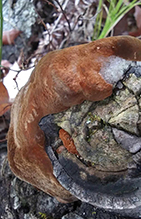 |
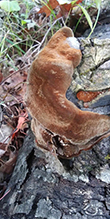 |
||||
Greg Watson |
|||||
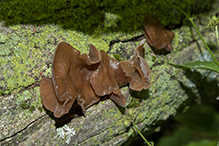 |
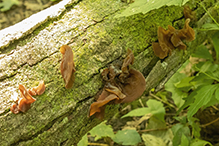 |
||||
MinnesotaSeasons.com Photos |
|||||
|
|||||

Slideshows |
||

Visitor Videos |
|||
Share your video of this fungus. |
|||
| This button not working for you? Simply email us at info@MinnesotaSeasons.com. Attach a video, a YouTube link, or a cloud storage link. |
|||
Other Videos |
|||
| Edible Jelly Mushrooms | Wood Ear & Amber Jelly Roll Learn Your Land |
|||
About
Jan 5, 2019 Subscribe to the Learn Your Land email newsletter here: https://confirmsubscription.com/h/i/8F756D78F98F8632 In this video, we take a look at two popular edible jelly mushrooms: the Wood Ear (Auricularia angiospermarum) and Amber Jelly Roll (Exidia recisa). |
|||

Visitor Sightings |
|||||
Report a sighting of this fungus. |
|||||
| This button not working for you? Simply email us at info@MinnesotaSeasons.com. Be sure to include a location. |
|||||
| Luciearl 10/16/2023 |
Location: Fairview Twp. |
||||
| Greg Watson 8/26/2022 |
Location: Eagles Bluff Park, La Crescent, MN |
||||
MinnesotaSeasons.com Sightings |
|||||
|
|||||

Created: 11/10/2022
Last Updated:
